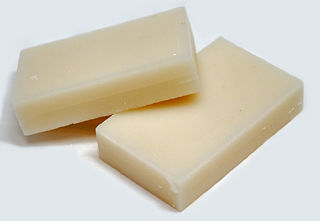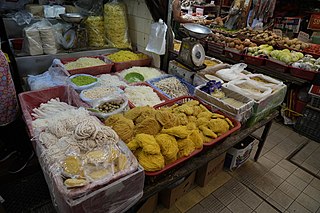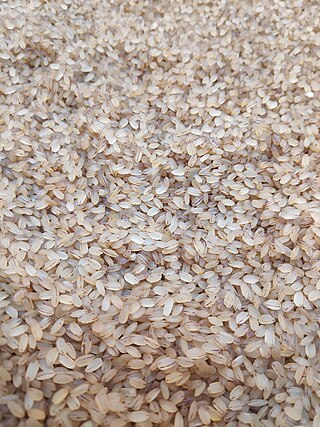
Starch or amylum is a polymeric carbohydrate consisting of numerous glucose units joined by glycosidic bonds. This polysaccharide is produced by most green plants for energy storage. Worldwide, it is the most common carbohydrate in human diets, and is contained in large amounts in staple foods such as wheat, potatoes, maize (corn), rice, and cassava (manioc).

Tapioca is a starch extracted from the tubers of the cassava plant, a species native to the North and Northeast regions of Brazil, but whose use is now spread throughout South America. It is a perennial shrub adapted to the hot conditions of tropical lowlands. Cassava copes better with poor soils than many other food plants.

Sago is a starch extracted from the pith, or spongy core tissue, of various tropical palm stems, especially those of Metroxylon sagu. It is a major staple food for the lowland peoples of New Guinea and the Maluku Islands, where it is called saksak, rabia and sagu. The largest supply of sago comes from Southeast Asia, particularly Indonesia and Malaysia. Large quantities of sago are sent to Europe and North America for cooking purposes. It is traditionally cooked and eaten in various forms, such as rolled into balls, mixed with boiling water to form a glue-like paste (papeda), or as a pancake.

Mochi is a Japanese rice cake made of mochigome (もち米), a short-grain japonica glutinous rice, and sometimes other ingredients such as water, sugar, and cornstarch. The steamed rice is pounded into paste and molded into the desired shape. In Japan, it is traditionally made in a ceremony called mochitsuki. While eaten year-round, mochi is a traditional food for the Japanese New Year, and is commonly sold and eaten during that time.

Sprouting is the natural process by which seeds or spores germinate and put out shoots, and already established plants produce new leaves or buds, or other structures experience further growth.

Bran, also known as miller's bran, is the component of a cereal grain consisting of the hard layers - the combined aleurone and pericarp - surrounding the endosperm. Corn (maize) bran also includes the pedicel. Along with the germ, it is an integral part of whole grains, and is often produced as a byproduct of milling in the production of refined grains. Bran is highly nutritious, but is difficult to digest due to its high fiber content; its high fat content also reduces its shelf life as the oils/fats are prone to becoming rancid. As such, it is typically removed from whole grain during the refining process - e.g. in processing wheat grain into white flour, or refining brown rice into white rice.

Chinese noodles vary widely according to the region of production, ingredients, shape or width, and manner of preparation. Noodles were invented in China, and are an essential ingredient and staple in Chinese cuisine. They are an important part of most regional cuisines within China, and other countries with sizable overseas Chinese populations.

Amylopectin is a water-insoluble polysaccharide and highly branched polymer of α-glucose units found in plants. It is one of the two components of starch, the other being amylose.
Starch gelatinization is a process of breaking down of intermolecular bonds of starch molecules in the presence of water and heat, allowing the hydrogen bonding sites to engage more water. This irreversibly dissolves the starch granule in water. Water acts as a plasticizer.

Nixtamalization is a process for the preparation of maize, or other grain, in which the grain is soaked and cooked in an alkaline solution, usually limewater, washed, and then hulled. The term can also refer to the removal via an alkali process of the pericarp from other grains such as sorghum.

Ben's Original, formerly called Uncle Ben's, is an American brand of parboiled rice and other related food products that were introduced by Converted Rice Inc., which is now owned by Mars, Inc. Uncle Ben's rice was first marketed in 1943 and was the top-selling rice in the United States until the 1990s. In 2020, it was rebranded as "Ben's Original" in the US.

Puffed rice and popped rice are types of puffed grain made from rice commonly eaten in the traditional cuisines of Southeast Asia, East Asia, and South Asia. It has also been produced commercially in the West since 1904 and is popular in breakfast cereals and other snack foods.

Resistant starch (RS) is starch, including its degradation products, that escapes from digestion in the small intestine of healthy individuals. Resistant starch occurs naturally in foods, but it can also be added as part of dried raw foods, or used as an additive in manufactured foods.
Instant rice is a white rice that is partly precooked and then is dehydrated and packed in a dried form similar in appearance to that of regular white rice. That process allows the product to be later cooked as if it were normal rice but with a typical cooking time of 5 minutes, not the 20–30 minutes needed by white rice. This process was invented by Ataullah K. Ozai‐Durrani in 1939 and mass-marketed by General Foods starting in 1946 as Minute Rice, which is still made.

Matta rice is an indigenous variety of rice grown in Udupi and Dakshina Kannada districts of Karnataka, Palakkad district of Kerala, India and in Jaffna district of Northern Province, Sri Lanka. It is known for its coarseness and health benefits. It is popular in Kerala and coastal Karnataka in India and Sri Lanka where it is used on a regular basis for idlies, appams and plain rice.

Instant noodles, or instant ramen, is a type of food consisting of noodles sold in a precooked and dried block with flavoring powder and/or seasoning oil. The dried noodle block was originally created by flash-frying cooked noodles, and this is still the main method used in Asian countries; air-dried noodle blocks are favored in Western countries. Dried noodle blocks are designed to be cooked or soaked in boiling water before eating. Ramen, a Japanese adaptation of Chinese noodle soup, is sometimes used as a descriptor for instant noodle flavors by some Japanese manufacturers. It has become synonymous in the United States with all instant noodle products.
In agriculture, grain quality depends on the use of the grain. In ethanol production, the chemical composition of grain such as starch content is important, in food and feed manufacturing, properties such as protein, oil and sugar are significant, in the milling industry, soundness is the most important factor to consider when it comes to the quality of grain. For grain farmers, high germination percentage and seed dormancy are the main features to consider. For consumers, properties such as color and flavor are most important.

Puffcorn or corn puffs are puffed or extruded corn snacks made with corn meal, which can be baked or fried.

Rice-cooking utensils are tools used for cooking rice and similar foods.
Rice is commonly consumed as food around the world. It occurs in long-, medium-, and short-grained types. It is the staple food of over half the world's population.

























